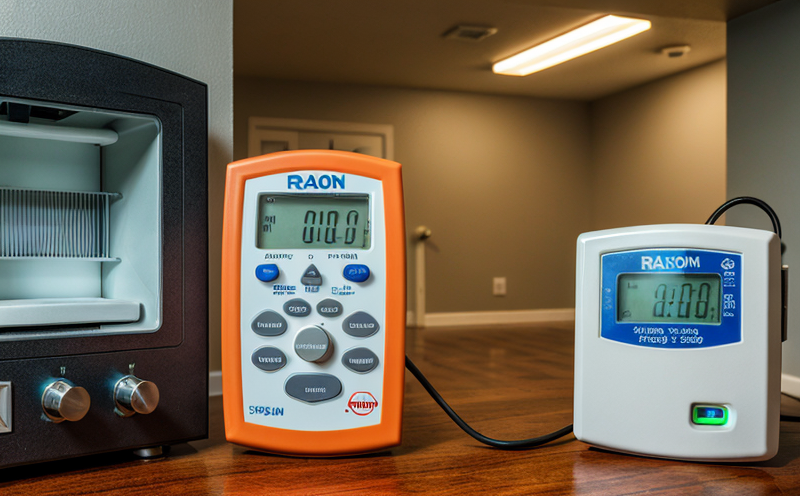ISO 11665-1 General Principles for Radon Measurement
The International Organization for Standardization (ISO) has established ISO 11665-1 as a global benchmark for the general principles of radon measurement. This standard is crucial for ensuring accuracy, reliability, and consistency in radon testing across various sectors such as residential construction, commercial buildings, public spaces, and environmental monitoring.
Radon is a colorless, odorless, and tasteless gas that poses significant health risks when present at elevated levels indoors. It is derived from the radioactive decay of uranium found naturally in soil and rocks. The World Health Organization (WHO) recommends reducing radon exposure to minimize the risk of lung cancer. ISO 11665-1 provides a framework for professionals to measure radon accurately, thereby contributing to public health and environmental safety.
The standard outlines the essential aspects of measurement techniques, equipment requirements, data handling, and reporting protocols. It emphasizes the importance of proper sampling procedures, calibration methods, and quality assurance practices. Compliance with ISO 11665-1 ensures that radon testing results are comparable across different regions and laboratories.
For residential properties, compliance with this standard is mandated by several countries to ensure safety standards are met. In commercial buildings, it helps in maintaining a healthy indoor environment for employees and visitors. Public health organizations also rely on ISO 11665-1 to monitor radon levels in areas where the gas might be more prevalent.
The implementation of ISO 11665-1 involves several key steps:
- Sampling Techniques: Proper sampling is critical for accurate measurement. The standard specifies various methods such as active and passive samplers, their placement, duration, and recovery rates.
- Calibration and Quality Control: Calibration of equipment using known radon sources ensures the accuracy of measurements. Regular quality control checks help maintain consistent results over time.
- Data Analysis: The collected data must be analyzed according to predefined criteria to determine compliance with local regulations or health guidelines.
- Reporting: Results should be reported clearly and concisely, detailing the measurement techniques used, sample locations, and any remediation measures suggested if necessary.
The application of ISO 11665-1 in practice involves collaboration among various stakeholders including architects, engineers, environmental scientists, and public health officials. By adhering to these principles, professionals can ensure that radon measurements are reliable, reproducible, and compliant with international standards.
In conclusion, the adoption of ISO 11665-1 is essential for protecting human health by reducing exposure to harmful radon levels indoors. This standard not only enhances safety but also promotes trust in testing results among regulatory bodies, clients, and the general public.
Industry Applications
| Application Area | Description of Use Case |
|---|---|
| Residential Construction | In residential buildings, ISO 11665-1 ensures that new homes are constructed with proper ventilation systems to minimize radon infiltration. Testing is conducted post-construction to verify compliance before occupancy. |
| Commercial Buildings | For commercial spaces like offices and retail areas, the standard helps maintain a healthy indoor environment by monitoring radon levels regularly. Remediation strategies can be implemented based on these tests. |
| Public Spaces | In public buildings such as schools and hospitals, ISO 11665-1 is critical for ensuring safe environments for occupants. Regular testing helps identify potential risks early. |
| Environmental Monitoring | For environmental agencies, this standard aids in tracking radon levels across different regions to assess overall air quality and public health impacts. |
The versatility of ISO 11665-1 allows it to be applied effectively in diverse settings where radon testing is necessary. Whether it’s for new construction or ongoing maintenance, the standard provides a robust framework that ensures accuracy and reliability in radon measurement.
Customer Impact and Satisfaction
The adoption of ISO 11665-1 brings numerous benefits to customers by ensuring that they receive accurate and reliable results from radon testing. This not only enhances public health but also builds trust between clients and service providers.
Customers who commission radon tests can be confident in the integrity of the process, knowing that it adheres to international standards. The standard’s emphasis on quality control and data accuracy ensures that test results are consistent and comparable across different locations or laboratories. This consistency is vital for making informed decisions about necessary remediation actions.
By implementing ISO 11665-1, customers can expect:
- Accurate Results: The standard ensures that radon levels are measured precisely using validated techniques and equipment.
- Compliance Assurance: Results align with local regulations and health guidelines, ensuring compliance without the need for additional testing.
- Enhanced Safety: Minimizing exposure to harmful radon levels protects occupants’ health and well-being.
- Reputational Benefits: Demonstrating adherence to international standards can enhance a company’s reputation in terms of quality and safety practices.
The ultimate goal of ISO 11665-1 is to provide peace of mind to customers by ensuring that radon testing is conducted with the highest level of professionalism and integrity. This, in turn, fosters customer satisfaction and loyalty.
Competitive Advantage and Market Impact
The implementation of ISO 11665-1 offers significant competitive advantages to laboratories and testing facilities that adopt this standard. It enhances their reputation for reliability and accuracy, which is crucial in a market where trust in test results is paramount.
By adhering to the principles outlined in ISO 11665-1, labs can differentiate themselves from competitors by offering more comprehensive and trustworthy services. This can lead to increased client satisfaction and loyalty, ultimately driving business growth.
The standard also opens up opportunities for collaboration with international organizations and government bodies that prioritize public health and safety. By aligning with global standards, labs can participate in larger projects or initiatives aimed at reducing radon exposure across regions.
In a broader market context, the implementation of ISO 11665-1 contributes to overall improvements in indoor air quality. As more labs adopt this standard, there is a collective effort towards creating safer environments for all. This not only benefits individual customers but also has wider societal implications, leading to greater market impact.





